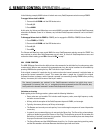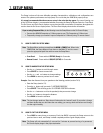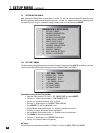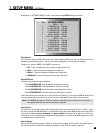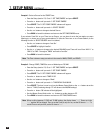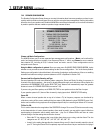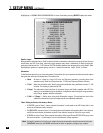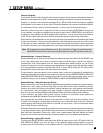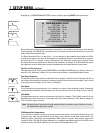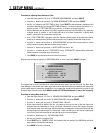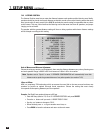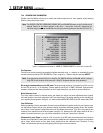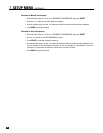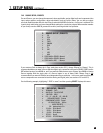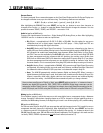
46
Crossover Frequency:
The crossover (Xover) divides the audio signal into two frequency bands, thereby restricting the amount of
bass sent to any speaker set to ‘Small’, and preventing midrange and treble from going to the subwoofer.
Using the buttons, choose a frequency between 25 Hz - 160 Hz suitable for the low frequency capability
of the speakers in your system. If you are using THX certified speakers, the crossover should be set to 80 Hz.
The subwoofer’s built-in crossover should be bypassed – be sure to set it to the highest frequency.
Note that a crossover does not cut frequencies off, but rolls them off. Setting XOVER FREQ to the very limit
of your speakers’ low frequency capability may not give the best results. If XOVER FREQ is set to 80 Hz, for
example, your main speakers will still be playing lower frequencies – they just won’t have to play them as
loudly. This also lightens the load on the amplifier, leaving extra power for mid and high frequencies.
Bass response is most dependent on room acoustics, and some experimentation with subwoofer placement
is highly recommended – start by placing the subwoofer in the listening area, play some music with a range
of bass notes, and walk around the room. Locations where bass sounds even, without certain notes being
much louder than others, are usually good spots for placing the subwoofer and getting response that’s even.
Note: LFE is redirected only when Subwoofer is set to ‘No’. If set to ‘Yes’ or ‘Super’, Cinema Configuration
XOVER FREQ should not be set much lower than 80 Hz, otherwise some LFE information will be lost.
Advanced Settings – Crossover Frequency:
Advanced Settings let you tailor Crossover Frequency settings more precisely. When ‘ADV SETTINGS’ is set
to ‘On’, each speaker type can be set to a Crossover Frequency that best suits its specific low frequency
characteristics. Even large speakers that can handle extended bass benefit because you can set the
Crossover Frequency to a very low setting and prevent them from receiving signals that are better handled
by a high performance subwoofer. Scrolling below ‘25 Hz’ or above ‘160 Hz’ brings the ‘Off’ setting, which
bypasses the crossover and sends a full-range signal to the speaker.
If room acoustics cause cancellation in the crossover region, sound can be improved by overlapping the
Subwoofer setting with the settings of other speakers, for instance setting L/R FRONTS XOVER to 70 Hz while
setting SUB/LFE XOVER to 90 Hz. On the other hand, if there is a bass peak in the crossover region, you can
spread the settings, such as setting L/R FRONTS XOVER to 100 Hz and SUBWOOFER XOVER to 80 Hz.
Advanced Settings – Subwoofer Phase and Polarity:
Room acoustics vary. If you have the flexibility, experiment with subwoofer placement to determine where it
sounds best in your system, providing deep, tight, and well defined bass. Certain subwoofer positions,
however, may cause bass frequency cancellation, meaning that when your front speakers and subwoofer
are “out-of-phase”, they work against each other, resulting in weak and sometimes dislocated sounding
bass. This can be corrected by adjusting the Subwoofer Phase and Polarity settings in this submenu.
If your subwoofer has phase and/or polarity controls, set them to zero/normal before making any
adjustments to the AVM 30’s Subwoofer Phase and Polarity settings.
As a general guide, set Polarity to ‘Normal’ if the subwoofer is placed close to the front speakers, and to
‘Inverted’ if the subwoofer is located behind the listening area or toward the back of the room. With bass
material playing, switch Polarity from ‘Normal’ to ‘Inverted’ as a quick check – leave it in the position where
bass is louder and more solid sounding.
Subwoofer Phase allows you to take things a step further and fine tune the phase alignment of the subwoofer
to your front speakers. Again, adjust Phase for the least amount of cancellation by listening for loudest and
most solid bass. Alternatively, listen to the ‘shhhh’ noise created between FM radio stations, and adjust
Phase until you find the most natural sounding transition between your main speakers and subwoofer.
Advanced Settings – Bypass LFE Crossover:
If you have set SUB/LFE XOVER to much lower than 80 Hz, the upper portion of the LFE signal will be lost.
With BYPASS LFE XOVER set to ‘Yes’, LFE goes to the subwoofer without going through the crossover,
preventing loss of LFE information. This also applies to the 6-Ch input’s SUB input (effectively, an LFE input).
7. SETUP MENU continued …



